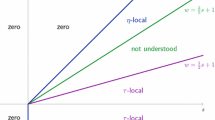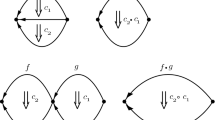Abstract
In this note, we show the existence of motivic structures on certain objects arising from the higher (rational) homotopy groups of non-nilpotent spaces. Examples of such spaces include several families of hyperplane arrangements. In particular, we construct an object in Nori’s category of motives whose realization is a certain completion of \(\pi _{n}({\mathbb P}^{n} {\setminus } \{L_{1}, \ldots , L_{n+2}\})\) where the \(L_{i}\) are hyperplanes in general position. Similar results are shown to hold in Vovoedsky’s setting of mixed motives.
Similar content being viewed by others
Notes
A pointed topological space is nilpotent if \(\pi _{1}(X,x)\) is nilpotent, and acts nilpotently on all higher homotopy groups.
A space is M-nilpotent if \(\pi _{1}(X,x)\) is nilpotent and acts nilpotently on \(\pi _{n}(X)\) for all \(n <M\).
While this is contrary to standard notation, it is consistent with that of [7].
One has \(Q{\mathfrak B}^{-N} = \oplus _{-s > -N} QBar^{-s}(A)\).
In the following, we fix such an embedding. However, the construction of Nori’s category of motives does not depend on the choice of embedding.
References
Bousfield, A.K., Gugenheim, V.K.A.M.: On \({\rm PL}\) de Rham theory and rational homotopy type. Mem. Amer. Math. Soc. 8(179), ix+94 (1976)
Bousfield, A.K., Kan, D.M.: Homotopy Limits, Completions and Localizations. Lecture Notes in Mathematics, vol. 304. Springer, Berlin (1972)
Brown, F.: Mixed Tate motives over \({\mathbb{Z}}\). Ann. Math. 175(2), 949–976 (2012). doi:10.4007/annals.2012.175.2.10
Deligne, P.: Le groupe fondamental de la droite projective moins trois points. In: Galois groups over \({\bf Q\it }\) (Berkeley, CA, 1987), Math. Sci. Res. Inst. Publ., vol. 16, pp. 79-297. Springer, New York (1989)
Deligne, P.: Le groupe fondamental unipotent motivique de \({\mathbf{G}}_{m}-\mu _{N}\), pour \(N\)=2,3,4,6 ou 8. Publ. Math. Inst. Hautes Études Sci. 112, 101–141 (2010). doi:10.1007/s10240-010-0027-6
Deligne, P., Goncharov, A.B.: Groupes fondamentaux motiviques de Tate mixte. Ann. Sci. École Norm. Sup. 38(1), 1–56 (2005). doi:10.1016/j.ansens.2004.11.001
Gartz, K.M.: A construction of a Differential Graded Lie Algebra in the Category of Effective Homological Motives. ProQuest LLC, Ann Arbor, MI (2003). Thesis (Ph.D.), The University of Chicago. http://gateway.proquest.com/openurl?url_ver=Z39.88-2004&rft_val_fmt=info:ofi/fmt:kev:mtx:dissertation&res_dat=xri:pqdiss&rft_dat=xri:pqdiss:3088737
Hain, R.M.: The de Rham homotopy theory of complex algebraic varieties. I. \(K\)-Theory 1(3), 271-324 (1987). doi:10.1007/BF00533825
Hain, R.M.: The de Rham homotopy theory of complex algebraic varieties. II. \(K\)-Theory 1(5), 481-497 (1987). doi:10.1007/BF00536980
Hattori, A.: Topology of \(C^{n}\) minus a finite number of affine hyperplanes in general position. J. Fac. Sci. Univ. Tokyo Sect. IA Math. 22(2), 205–219 (1975)
Huber, A.: Realization of Voevodsky’s motives. J. Algebraic Geom. 9(4), 755–799 (2000)
Huber, A.: Corrigendum to: “Realization of Voevodsky’s motives” [J. Algebraic Geom. 9 (2000), no. 4, 755–799; mr1775312]. J. Algebraic Geom. 13(1), 195–207 (2004). doi:10.1090/S1056-3911-03-00374-6
Huber, A., Muller-Stach, S.: On the relation between nori motives and kontsevich periods. arXiv:1105.0865v4 [math.AG]
Levine, M.: Mixed Motives. Handbook of \(K\)-Theory, pp. 429-521. Springer, Berlin (2005). doi:10.1007/3-540-27855-9_10
McCleary, J.: A User’s Guide to Spectral Sequences, Cambridge Studies in Advanced Mathematics, 2nd edn. Cambridge University Press, Cambridge (2001)
Morgan, J.W.: The algebraic topology of smooth algebraic varieties. Inst. Hautes Études Sci. Publ. Math. 48, 137-204 (1978). http://www.numdam.org/item?id=PMIHES_1978__48__137_0
Nori, M.: An abelian category of motives. Personal Communitcation
Papadima, S., Suciu, A.I.: Higher homotopy groups of complements of complex hyperplane arrangements. Adv. Math. 165(1), 71–100 (2002). doi:10.1006/aima.2001.2023
Sullivan, D.: Infinitesimal computations in topology. Inst. Hautes Études Sci. Publ. Math. (47), 269-331 (1978)
Voevodsky, V., Suslin, A., Friedlander, E.M.: Cycles, Transfers, and Motivic Homology Theories, Annals of Mathematics Studies, vol. 143. Princeton University Press, Princeton (2000)
Wildeshaus, J.: Notes on artin-tate motives. arXiv:0811.4551v2 [math.AG]
Acknowledgments
It will be clear the debt this article owes to the ideas of Professor Nori as well as K. Gartz. The author would like to thank Professor Nori for suggesting the above problem and patiently explaining his ideas.
Author information
Authors and Affiliations
Corresponding author
Ethics declarations
Conflict of interest
The author declares that he has no conflict of interest.
Rights and permissions
About this article
Cite this article
Patel, D. Motivic structures on higher homotopy groups of hyperplane arrangements. Math. Ann. 366, 279–300 (2016). https://doi.org/10.1007/s00208-015-1326-5
Received:
Revised:
Published:
Issue Date:
DOI: https://doi.org/10.1007/s00208-015-1326-5




